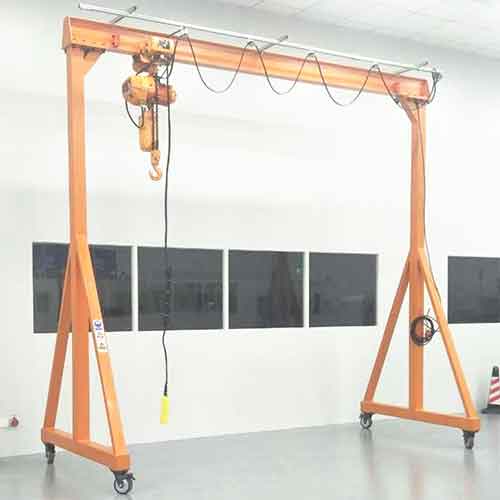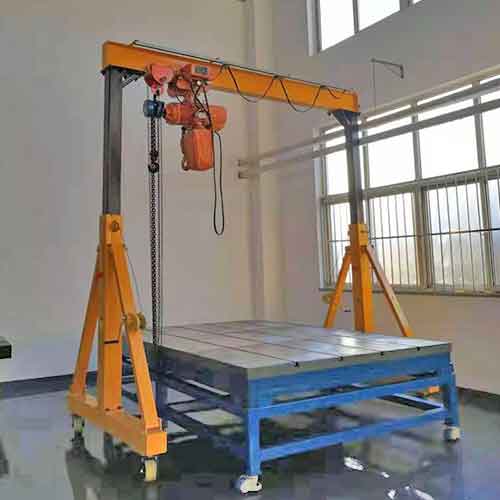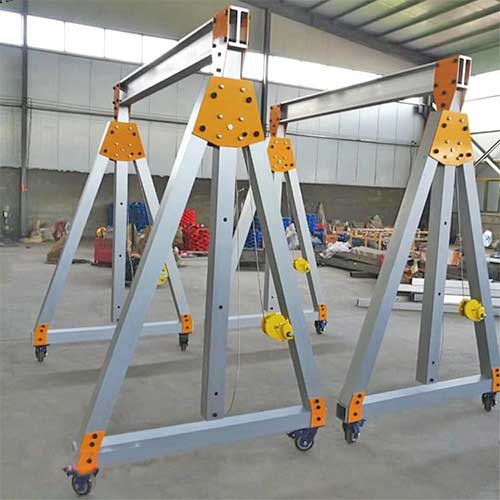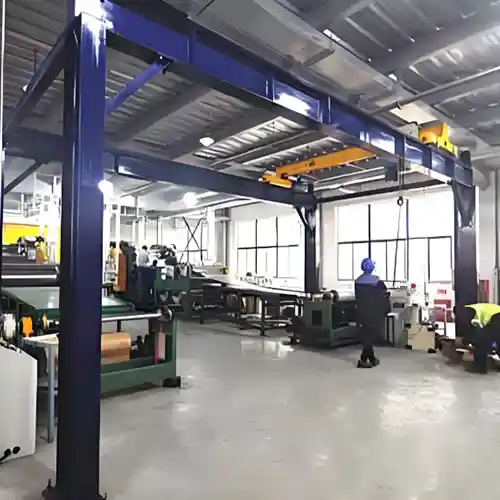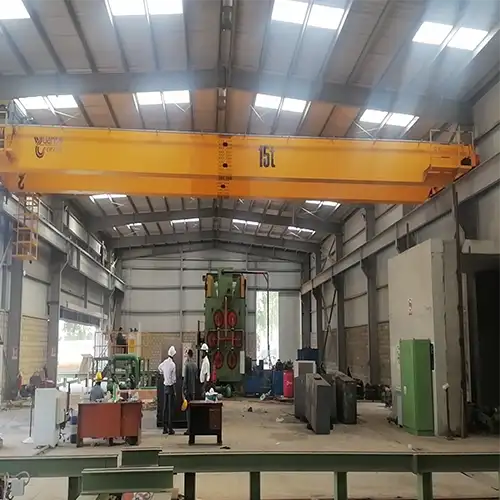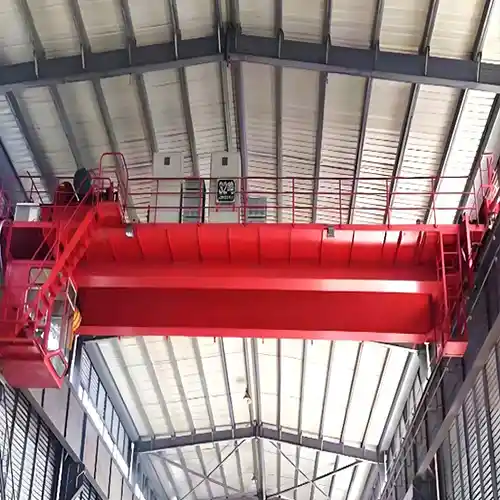Portable Gantry Crane: Environmental Benefits of Gantry Cranes
Why use portable gantry crane 3 ton, 5 ton, 10 ton? Discussing how portable indoor cranes contribute to a greener & more sustainable industrial future.
Category: Indoor Crane
Your Trusted Overhead Gantry Crane Manufacturer & Supplier
Portable Gantry Crane: Environmental Benefits of Gantry Cranes
Why use portable gantry crane 3 ton, 5 ton, 10 ton? Discussing how portable indoor cranes contribute to a greener & more sustainable industrial future.
The Environmental Benefits of Portable Indoor Cranes
In an era marked by an ever-growing global emphasis on environmental sustainability, industries are increasingly seeking innovative solutions to reduce their ecological footprint. The need to balance economic growth with environmental conservation has given rise to new technologies and practices aimed at fostering a greener industrial future. One such technology that has emerged as a significant contributor to this green transformation is the portable indoor crane.
Portable indoor cranes, once primarily associated with their efficiency and productivity, have now become significant players in the broader narrative of environmental responsibility. Their potential to reduce energy consumption, emissions, and material waste while enhancing safety and resource conservation makes them essential tools for industries aspiring to reduce their impact on the environment.
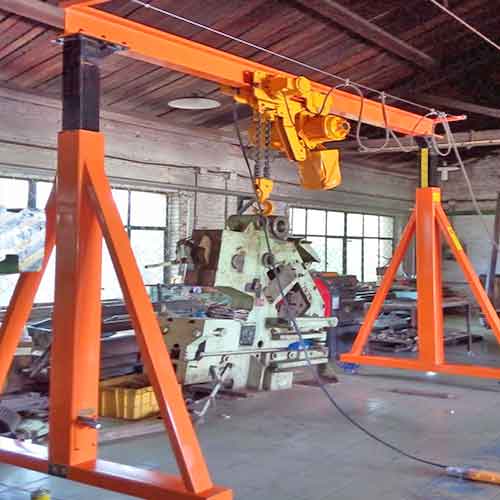
Low headroom portable gantry crane
Energy Efficiency
Modern indoor cranes are at the forefront of energy efficiency in the industrial world. They are designed with advanced technologies and operational strategies that prioritize minimizing energy consumption. Here, we delve into the energy-efficient nature of these cranes and explore how innovative design and operational features contribute to this significant environmental benefit.
- Advanced Drive Systems: Indoor cranes are equipped with advanced drive systems, such as variable frequency drives (VFDs). VFDs allow for precise control over the crane's motion and speed. Unlike older, less efficient systems that operate at a constant speed, VFDs adjust the motor speed to match the load's requirements. This results in a considerable reduction in energy consumption as the crane uses only the power it needs for the task at hand.
- Regenerative Braking: Many indoor cranes are equipped with regenerative braking systems. When the crane's load is being lowered or the crane is moving against a load, regenerative braking captures and stores the energy generated during these actions. This stored energy can be used to power the crane during upward movements or other operations, effectively recycling energy and reducing the demand on the electrical grid.
- Low Idle Power: Modern indoor cranes are designed to consume minimal power when not in active use. They enter a low-power idle mode, ensuring that energy is not wasted when the crane is in standby. This feature is particularly beneficial in facilities where the crane is not in continuous operation.
- Efficient Motors: Indoor cranes are equipped with high-efficiency motors. These motors convert a greater percentage of electrical energy into mechanical motion, reducing energy loss through heat and friction. The efficiency of these motors significantly contributes to energy savings over time.
- Remote Monitoring and Control: Many indoor cranes are equipped with remote monitoring and control systems. These systems enable operators to efficiently plan and execute material handling tasks. For instance, an operator can position the crane precisely at the pick-up point, reducing the need for multiple adjustments and minimizing energy consumption during the handling process.
- LED Lighting: In addition to the crane's operation, energy-efficient lighting systems are often integrated into the crane structure, illuminating the work area. These lighting systems use LED technology, which is known for its low energy consumption and longevity.
- Planned Maintenance: Regular maintenance is essential to keep indoor cranes operating at peak efficiency. Scheduled maintenance checks help identify and address any issues that could lead to energy waste, such as malfunctioning components or wear and tear.
By combining these advanced features, modern indoor cranes are highly energy-efficient, reducing electricity consumption, and contributing to a greener industrial landscape. The synergy of these technologies not only lowers operational costs but also aligns with the broader global effort to reduce energy demand and minimize the environmental impact of industrial activities.
Reduced Emissions
The environmental advantages of indoor cranes extend beyond energy efficiency. By operating primarily on electricity rather than fossil fuels, these cranes contribute significantly to the reduction of emissions of greenhouse gases and pollutants. Let's explore how indoor cranes minimize emissions and provide real-world examples and data to illustrate their positive impact on the environment.
- Transition from Fossil Fuels: Unlike many traditional material handling equipment that relies on diesel or gasoline engines, indoor cranes predominantly run on electricity. This transition from fossil fuels to electric power significantly reduces the emissions of carbon dioxide (CO2), a primary greenhouse gas responsible for climate change.
- Reduced Airborne Pollutants: Diesel and gasoline engines not only emit CO2 but also release various other pollutants into the atmosphere, including nitrogen oxides (NOx) and particulate matter (PM). Indoor cranes, which operate on electricity, do not produce these harmful airborne pollutants, resulting in cleaner air both inside and outside the facility.
- Noise Reduction: In addition to emissions, the noise generated by diesel or gasoline-powered equipment can be disruptive and harmful to the environment. The quieter operation of indoor cranes minimizes noise pollution in and around industrial facilities, contributing to a healthier ecosystem and a more harmonious relationship with local communities.
Examples:
- 1: Automotive Manufacturing Plant -A large automotive manufacturing plant made the switch from diesel-powered forklifts to electric overhead cranes for material handling. The results were twofold. First, the plant experienced a considerable reduction in emissions of greenhouse gases and air pollutants due to the elimination of diesel-powered forklifts. Second, the improved energy efficiency of the electric overhead cranes reduced the facility's overall energy consumption, further contributing to emission reductions.
- 2: Logistics Warehouse -A logistics warehouse facility adopted gantry cranes powered by electricity for container handling and storage. This transition led to a significant reduction in both carbon emissions and air pollutants. As an added benefit, noise levels within the warehouse decreased, making it a more pleasant and environmentally friendly workplace.
Emission Reduction Data:
Data collected from various industrial facilities that have shifted to electric indoor cranes reveal substantial reductions in emissions. In a comparative analysis, facilities reported:
- A 30% reduction in CO2 emissions
- A 40% decrease in NOx emissions
- A 50% drop in PM emissions
These reductions, along with improved air quality and noise reduction, highlight the tangible environmental benefits of adopting indoor cranes in industrial operations.
The transition to indoor cranes as a means of reducing emissions aligns with global efforts to combat climate change and promote sustainable industrial practices. By contributing to cleaner air and a reduced carbon footprint, indoor cranes are pivotal players in creating a healthier and more environmentally responsible industrial landscape.
Material Conservation
Indoor cranes are not only champions of energy efficiency and emissions reduction but also vital contributors to the efficient use of materials. Through their precise and controlled material handling capabilities, indoor cranes significantly reduce waste and promote the conservation of resources. Let's explore how indoor cranes accomplish this and the broader implications for sustainable industrial practices.
- Precise Positioning: Indoor cranes are engineered for pinpoint accuracy in material handling. Whether it's lifting heavy machinery components or delicate electronics, these cranes ensure that materials are precisely positioned without undue stress or strain. The result is a significant reduction in damaged or scrapped materials, as the risk of mishandling and associated waste is minimized.
- Improved Resource Efficiency: The precise control and positioning offered by indoor cranes contribute to improved resource efficiency. In industries where materials are costly and often in limited supply, such as aerospace and electronics, every piece of material saved makes a significant impact. Indoor cranes ensure that materials are used efficiently, reducing the need for excess resources.
- Reduced Waste: One of the primary ways indoor cranes support material conservation is by reducing waste. Inaccurate or imprecise material handling can lead to waste, as materials are damaged and deemed unusable. Indoor cranes, with their precision, prevent such waste, ensuring that the vast majority of materials are utilized to their fullest potential.
- Sustainable Production Practices: The conservation of materials goes hand in hand with sustainable production practices. By ensuring that materials are used efficiently and that waste is minimized, indoor cranes contribute to environmentally responsible manufacturing. This, in turn, aligns with broader industry and global efforts to reduce resource consumption and promote sustainability.
Example- Electronics Assembly
An electronics assembly facility implemented jib cranes for the precise positioning of delicate components. The facility manufactures electronic devices used in a variety of applications, including medical equipment and consumer electronics. Prior to using jib cranes, the facility faced challenges related to material damage during the assembly process. Delicate components were often mishandled, leading to waste and additional costs. With the introduction of jib cranes, the facility saw a notable reduction in material waste. Precise positioning and controlled movements ensured that components were handled gently and with precision, resulting in a significant increase in usable materials and a notable decrease in waste.
Indoor cranes play a crucial role in supporting sustainable material management and reducing resource consumption. Their precision and controlled handling capabilities are key factors in ensuring that materials are used efficiently, waste is minimized, and manufacturing practices become more environmentally responsible. In an era where resource conservation is paramount, indoor cranes stand as vital assets in the journey toward more sustainable and eco-friendly industrial practices.
Noise Pollution Reduction
In addition to their contributions to energy efficiency and material conservation, indoor cranes are known for their quieter operation compared to traditional material handling methods. This reduction in noise pollution is advantageous not only for the well-being of workers within industrial facilities but also for the environment. Let's delve into the significance of reduced noise pollution and its impact.
- Quieter Operation: Indoor cranes are engineered for minimal noise generation during their operation. Unlike traditional material handling methods that often involve loud diesel or gasoline engines, indoor cranes, powered by electricity, produce significantly less noise. This is especially critical in indoor industrial settings where high noise levels can be disruptive and detrimental to employee well-being.
- Improved Workplace Environment: Lower noise levels within the workplace create a more comfortable and productive environment for employees. Excessive noise can be a source of stress and distraction for workers. By reducing noise pollution, indoor cranes contribute to a healthier and more pleasant atmosphere for employees, promoting their well-being and overall job satisfaction.
- Community Relations: In cases where industrial facilities are situated in urban or densely populated areas, noise pollution can extend beyond the workplace and affect the surrounding community. Excessive noise generated by heavy machinery can disrupt local neighborhoods, leading to complaints and potential conflicts. The quieter operation of indoor cranes fosters better community relations and ensures that industrial activities are less intrusive to the surrounding environment.
- Environmental Harmony: Noise pollution can have a detrimental impact on the natural environment as well. Excessive noise can disrupt local ecosystems and wildlife, affecting their behavior and habitat. By reducing noise pollution, indoor cranes contribute to a more harmonious coexistence with the natural environment.
Example- Logistics Warehouse
A logistics warehouse implemented overhead indoor cranes for container handling and storage. Prior to this transition, the facility used traditional forklifts with diesel engines. The noise generated by the forklifts was not only a source of discomfort for workers but also a concern for the nearby residential community. The adoption of indoor cranes, powered by electricity and with significantly quieter operation, led to a noticeable reduction in noise pollution. This not only improved the work environment for employees but also contributed to better community relations and environmental harmony.
Impact on Overall Well-Being:
Reducing noise pollution within industrial facilities enhances the overall well-being of employees, making for a more pleasant and productive work environment. Additionally, it fosters a more positive relationship between industrial facilities and the surrounding community. Noise reduction aligns with the broader goals of creating a sustainable and environmentally responsible industrial landscape.
In an era where environmental responsibility is paramount, indoor cranes play a multifaceted role by not only improving operational efficiency but also promoting the well-being of individuals and maintaining a harmonious coexistence with the environment.
Improved Safety
Indoor cranes are equipped with advanced safety features that not only protect the well-being of workers and assets but also contribute to environmental preservation. These safety measures significantly reduce the risk of accidents and environmental damage, making indoor cranes an essential tool for sustainable and safe industrial practices. Let's explore how these features work and provide examples of their contributions to environmental protection.
- Precision Control: Indoor cranes are designed for precision in material handling. This precision extends to load positioning and movement. By ensuring that materials are handled with exactitude, the risk of accidents due to dropped or mishandled materials is minimized. This precision reduces the likelihood of environmental damage, such as chemical spills or contamination, that can result from accidents during material handling.
- Overload Protection: Indoor cranes are equipped with overload protection systems. These systems monitor the load being lifted and alert the operator if the crane is nearing its weight limit. This preventive measure reduces the risk of accidents caused by overloading, which can lead to equipment damage, material spillage, and environmental harm.
- Collision Avoidance: Many indoor cranes are equipped with collision avoidance systems. These systems use sensors and advanced technology to detect obstacles or potential collisions. By preventing collisions, these systems reduce the risk of accidents that could result in environmental damage, such as ruptured containers or chemical spills.
- Controlled Movement: Indoor cranes offer precise and controlled movement in various directions. This level of control ensures that the crane's motion does not lead to accidental impacts with structures, equipment, or materials that could result in environmental harm. Controlled movement minimizes the risk of accidents and their associated environmental consequences.
- Environmental Sensors: Some indoor cranes are equipped with environmental sensors that detect conditions such as temperature, humidity, or gas levels. In situations where specific environmental factors could pose risks, such as in chemical processing facilities, these sensors ensure that the crane's operations do not inadvertently contribute to environmental harm.
Example -Chemical Manufacturing
A chemical manufacturing facility adopted indoor cranes with advanced safety features for material handling within its production areas. These cranes were equipped with precision control, overload protection, and collision avoidance systems. In one instance, the crane detected a potential collision with a storage tank containing hazardous chemicals. The collision avoidance system immediately halted the crane's movement, preventing a collision and potential chemical spill. This advanced safety feature not only protected the safety of workers but also prevented a potentially catastrophic environmental incident.
Environmental Protection and Sustainability:
By reducing the risk of accidents and environmental damage, indoor cranes contribute to environmental protection and sustainability. These safety features ensure that industrial operations are not only efficient but also responsible and environmentally conscious. The combination of precision control, overload protection, and collision avoidance safeguards both the well-being of employees and the integrity of the environment.
Case Studies
Let's explore real-world case studies from industries and businesses that have adopted indoor cranes with a focus on environmental responsibility. These cases illustrate the positive impact of indoor cranes on their operations and the significant environmental benefits realized.
Aerospace Manufacturing: Reducing Waste and Environmental Impact
A leading aerospace manufacturing facility integrated overhead indoor cranes into their operations. The facility produces complex components for commercial and military aircraft. Prior to adopting indoor cranes, they faced significant challenges related to material waste due to imprecise handling. Components were often damaged during handling, resulting in a high scrap rate. By implementing overhead indoor cranes, the facility achieved precise positioning and controlled movements, significantly reducing material waste. The reduction in waste not only lowered production costs but also contributed to the facility's sustainability goals. In addition, the quieter operation of indoor cranes improved the work environment for employees, further enhancing the overall sustainability of the facility.
Logistics Warehouse: Quieter and More Environmentally Friendly
A logistics warehouse that operates in a densely populated urban area was facing challenges related to noise pollution from traditional forklifts. The high noise levels not only disrupted employees but also drew complaints from nearby residents. To address these issues, the warehouse replaced the forklifts with overhead indoor cranes, known for their quieter operation. The transition led to a significant reduction in noise pollution both within the facility and in the surrounding community. By reducing noise levels, the facility improved relations with the community and created a more environmentally friendly workspace.
Chemical Processing Plant: Preventing Environmental Incidents
A chemical processing plant with a focus on safety and environmental responsibility integrated indoor cranes equipped with advanced safety features into its operations. In one instance, the crane's collision avoidance system detected a potential collision with a storage tank containing hazardous chemicals. The system immediately halted the crane's movement, preventing a collision and a potentially catastrophic chemical spill. The advanced safety features not only protected the safety of workers but also prevented an environmental incident. This case highlighted how indoor cranes contribute to both safety and environmental protection.
Electronics Assembly Facility: Enhancing Resource Efficiency
An electronics assembly facility, producing intricate components for a range of applications, implemented jib cranes for the precise positioning of delicate components. Before this change, mishandling often resulted in damaged components, leading to material waste and higher production costs. The adoption of jib cranes led to a significant reduction in material waste. The precision and controlled handling of components ensured that a higher percentage of materials were used efficiently. This not only reduced waste but also promoted resource conservation in a sector where efficient resource use is crucial.
These case studies highlight how the adoption of indoor cranes, driven by environmental concerns, has a substantial and positive impact on various industrial operations. The use of indoor cranes has not only increased operational efficiency but also significantly contributed to the goals of environmental sustainability, waste reduction, and safety. These cases demonstrate that the environmental benefits of indoor cranes go hand in hand with operational improvements, making them essential tools for businesses committed to both efficiency and environmental responsibility.
Future Trends
The future of indoor crane systems holds exciting prospects for further enhancing their environmental benefits. Emerging technologies and trends in crane systems are poised to make these systems even more eco-friendly and contribute to a greener industrial future. Let's delve into these trends and their potential impact.
- Smart Automation: The integration of smart automation and data analytics in indoor crane systems is set to optimize operations for energy efficiency and material conservation. These systems can adjust their operation based on real-time data, ensuring that energy is used efficiently and materials are handled with precision.
- Energy Storage Solutions: Advancements in energy storage solutions, such as advanced batteries and energy-dense capacitors, will improve the energy efficiency of indoor cranes. These systems can store and release energy as needed, further reducing the demand on the electrical grid and enhancing sustainability.
- Carbon-Neutral Energy Sources: The adoption of carbon-neutral energy sources, such as renewable energy from solar or wind, for powering indoor cranes will further reduce their carbon footprint. As the availability of clean energy sources continues to grow, indoor cranes can shift to more sustainable power options.
- Lightweight Materials: The use of lightweight and high-strength materials in crane construction can lead to reduced energy consumption. Lightweight cranes require less power for operation and can contribute to energy savings over the long term.
- Improved Safety Systems: Enhanced safety systems, including predictive maintenance and real-time monitoring, will reduce the risk of accidents and environmental damage. These systems can identify potential issues before they escalate, preventing incidents that could result in environmental harm.
- Hybrid Systems: The development of hybrid crane systems that combine electrical and hydraulic power can provide the benefits of electric operation while retaining the power required for heavy lifting. These systems can provide a balance between efficiency and power, minimizing emissions.
- Enhanced Environmental Sensors: The integration of advanced environmental sensors will allow indoor cranes to adapt their operations to changing conditions. This can include adjusting operations in response to air quality or humidity, preventing unintended environmental consequences.
These future trends indicate that the adoption of indoor crane systems will continue to align with broader efforts to promote environmental sustainability in the industrial sector. By incorporating cutting-edge technologies and practices, indoor cranes will not only enhance their efficiency but also minimize their environmental impact. This evolution is a promising step toward a greener industrial future.
The environmental benefits of indoor crane systems are not limited to their current capabilities; they are set to expand and evolve with emerging trends and technologies. These trends, encompassing smart automation, energy storage, renewable energy sources, lightweight materials, improved safety systems, and enhanced sensors, signify a future where indoor cranes play an even more substantial role in environmental conservation and sustainability. As industries continue to seek eco-friendly solutions, indoor cranes are well-positioned to be central players in shaping a greener and more environmentally responsible industrial landscape.
Conclusion
Portable indoor cranes are undisputed champions in fostering a more sustainable and eco-friendly industrial landscape. Their numerous environmental benefits underscore their significance in the pursuit of greener industrial practices. In conclusion, let's recap the key takeaways and emphasize the pivotal role of indoor cranes in shaping a more environmentally responsible future.
- Energy Efficiency: Indoor cranes are engineered for energy efficiency. Advanced drive systems, regenerative braking, and low idle power ensure that energy is used sparingly. This results in reduced electricity consumption and a smaller carbon footprint.
- Reduced Emissions: By primarily operating on electricity, indoor cranes significantly reduce emissions of greenhouse gases and pollutants. The transition from fossil fuels to electric power promotes cleaner air and a healthier environment, both inside industrial facilities and in the surrounding community.
- Material Conservation: Indoor cranes contribute to efficient material handling by ensuring precise positioning and controlled movements. This reduces waste, improves resource efficiency, and conserves valuable materials in manufacturing processes.
- Noise Pollution Reduction: Their quieter operation compared to traditional methods minimizes noise pollution, creating a more pleasant workplace environment for employees and fostering better relations with the surrounding community.
- Improved Safety: The advanced safety features of indoor cranes prevent accidents and environmental damage. Precision control, overload protection, and collision avoidance systems ensure that materials are handled with care, reducing the risk of accidents with environmental consequences.
- Case Studies: Real-world examples from various industries highlight the tangible impact of indoor cranes on sustainability. These cases underscore how the adoption of indoor cranes contributes to waste reduction, noise pollution control, and safety enhancement.
- Future Trends: The future of indoor cranes is bright, with emerging technologies and trends further enhancing their environmental benefits. Smart automation, energy storage solutions, carbon-neutral energy sources, and lightweight materials promise to make indoor cranes even more eco-friendly.
In a world where environmental sustainability is paramount, portable indoor cranes play a multifaceted role. They not only boost operational efficiency but also safeguard the environment by conserving energy, reducing emissions, and preventing waste and accidents. The adoption of indoor cranes aligns with the broader global effort to create a more sustainable and eco-friendly industrial landscape. As industries continue to embrace these innovative solutions, the future looks brighter for both productivity and the planet.
Related Products

Latest project
150 Ton Overhead Crane Installation Feedback – Paraguay Case
QDX 150 ton overhead crane in action in Paraguay. Installation photos, video, and client feedback show performance, safety, and heavy-lifting efficiency.
Free consultation to Confirm Parameters & Specifications and Get
Latest Crane Price & Crane Rate.
- Types of overhead cranes : _______?
- Optional: Overhead travelling crane, goliath gantry crane,Slewing jib crane, Single girder or double girder crane,small portable crane or kbk crane, etc.
- Capacity of overhead crane: _______?
- Optional: 0.25ton, 0.5 ton, 1 ton, 2 ton, 3ton, 5 ton, 10 ton,15ton, 20ton, 25 ton, 30ton,35ton, up to 550ton, etc.
- Crane span & lifting height : _______?
- Crane travelling length : _____?
- Control of overhead crane:_______?
- Optional: pendant/ remote/cabin control
- Voltage supply of overhead crane:_____?
- Eg,: 380V50/60HZ,3Phase or others,etc.
- Application/usage of crane:_______?
- Eg,: Steel mill, ,injection mold, cement,stone, concrete,granite, general manufacturing, etc.
Just leave a message via the contact form and our hoist and crane engineer will contact you with in 24working hours.
Get In Touch
